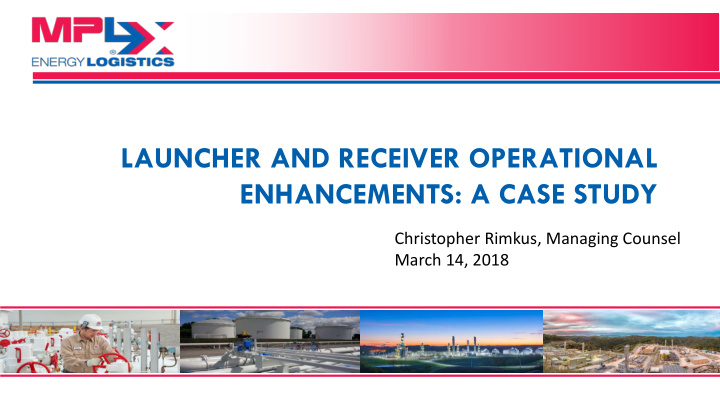



LAUNCHER AND RECEIVER OPERATIONAL ENHANCEMENTS: A CASE STUDY Christopher Rimkus, Managing Counsel March 14, 2018
Wellhead to Processing Plant
The Focus: Pigging Launcher/Receiver Operations Standard pipeline maintenance conducted for decades nationwide Uses a pig to sweep liquids Pig is inserted and removed from a small barrel (a “launcher” or “receiver”) that is isolated from the pipeline Launcher/receiver barrel is depressurized (“blown down”) for inserting, removing the pig: blowdowns accounted for 0.02% of gas gathered in PA prior to the start of this case For Settlement Purposes Only - F.R.E. 408 3
PIG LAUNCHER AND RECEIVER SITE 4
SEARCH WARRANT Pipeline operators show up to perform routine maintenance at the stand- alone launcher/receiver site in Pennsylvania. The maintenance work involves receiving a pig from the pipeline and launching the same, a common daily activity. While performing this routine work, federal agents raid the site around 8 a.m. and proceeded to stop operations, perform questioning and take samples. The agents complete their inspection and make requests for production of documents, but no further action was taken by the agents at that time.
MISCONCEPTIONS Following execution of the federal search warrant, it becomes clear that the search warrant is based, in large part, upon a number of misconceptions. Launching and receiving operations are routinely scheduled, and were not occurring in secret. Launchers and receivers do not vent the volume of the entire pipeline segment to atmosphere – they only vent the volume of the launcher and/or receiver barrel when inserting or retrieving the pig tool. 6
MISCONCEPTIONS (Cont.) Employees capture any NGLs or other liquids that may be in the barrel in a storage vessel, not release them to the ground. The public is categorically not at risk from launcher or receiver operations and no evidence has ever been presented substantiating any claim to the contrary. Worker safety is protected during launcher/receiver operations as studies conducted pre-search warrant attest. 7
METHANE Premise for search warrant and initial discussions with both DOJ and EPA focuses on public and worker safety. Methane claim couched as § 303 “Air Pollution Emergency” Claim Previous and subsequent scientific studies demonstrate that there is not imminent and substantial endangerment to workers or public. 8
BTEX Subsequent to § 303 discussions based upon methane, questions are raised regarding possible health-based exposures to BTEX. Leading worker exposure and emissions experts are enlisted – experts who provide advice to EPA on other air emission projects and enforcement matters – to evaluate BTEX at launcher/receiver sites. Experts conclude no health-based exposure issues for public or workers based upon BTEX. 9
VOCs EPA, states, and industry have traditionally been under the impression that launcher/receiver emissions were de minimis. During the course of reviewing launcher/receiver operations with respect to worker safety and public health after the raid, the company conservatively identifies a small subset (less than 10%) of launcher/receiver sites where emissions may be above applicable PA de minimis permitting thresholds. No motivation or benefit for not permitting Permits relatively easy to obtain either as minor sources or RFDs under SIP Design changes easy and inexpensive to make emissions fall below de minimis levels 10
EMISSIONS REDUCTION PROJECTS Launchers/Receivers: E MPLOY THE FOLLOWING DESIGN ENHANCEMENTS Piping from high pressure to low pressure where (1) located within 50 ft. of low pressure line and (2) practicable Installation of a pig ramp Where practicable, a shorter barrel design Draft GP-5a in PA includes these design enhancements 11
COMBUSTION CONTROL DEVICES Combustion control devices can be used when: jumper lines, pig ramps, and updated operating procedures DO NOT REDUCE ACTUAL EMISSIONS BELOW APPLICABLE DE MINIMIS THRESHOLD Consider enclosed flares to minimize impact to public Also consider portable, trailer-mounted flares, in jurisdictions like Ohio given different operating constraints 12
STANDARD OPERATING PROCEDURES Incorporate the following standard operating procedures into training materials: 1 minute/10’ step-back Personal 4-gas monitor at chest height Process for ensuing barrel does not repressurize Protocol for response to LEL alarms Laminated job safety checklists for each site Respiratory protection for changing out charcoal filters at compressor stations 13
EMISSIONS REDUCTION 84.7% R EDUCTION OF T OTAL E MISSIONS 800 mm ft 3 /day processed in the PA system 0.02% of total volume was emitted from launcher and receiver loading operations prior to EPA inspection 84.7% reduction in emissions system wide post inspection 0.003% of total volume is emitted from current launcher and receiver loading operations 14
QUESTIONS & ANSWERS 15
Recommend
More recommend